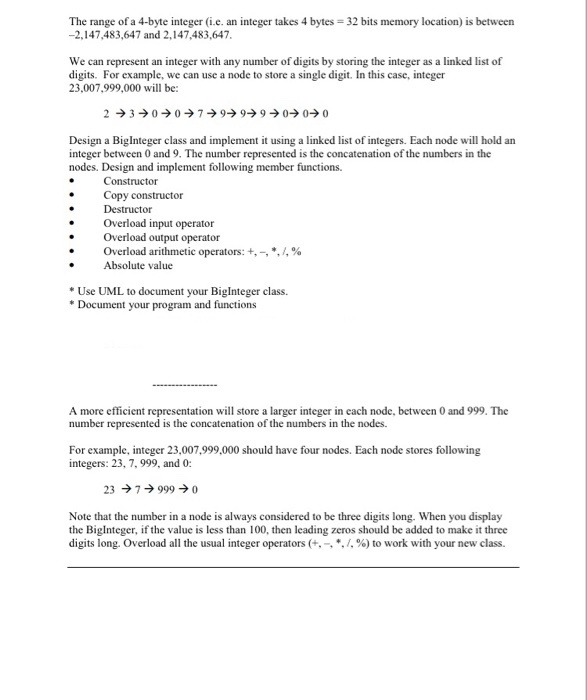The range of a 4-byte integer (i.e. an integer takes 4 bytes 32 bits memory location) is between -2,147,483,647 and 2,147,483,647 We can represent an integer with any number of digits by storing the integer as a linked list of digits. For example, we can use a node to store a single digit. In this case, integer 23.007,999,000 will be: 2 30079 9 9 0 0 0 Design a BigInteger class and implement it using a linked list of integers. Each node will hold an integer between 0 and 9. The number represented is the concatenation of the numbers in the nodes. Design and implement following member functions. Constructor Copy constructor Destructor Overload input operator Overload output operator Overload arithmetic operators: +,-, *, /, % Absolute value Use UML to document your BigInteger class. Document your program and functions A more efficient representation will store a larger integer in each node, between 0 and 999The number represented is the concatenation of the numbers in the nodes. For example, integer 23,007,999,000 should have four nodes. Each node stores following integers: 23, 7, 999, and 0: 23 7999 0 Note that the number in a node is always considered to be three digits long. When you display the BigInteger, if the value is less than 100, then leading zeros should be added to make it three digits long. Overload all the usual integer operators (+,-, *. /. %) to work with your new class. The range of a 4-byte integer (i.e. an integer takes 4 bytes 32 bits memory location) is between -2,147,483,647 and 2,147,483,647 We can represent an integer with any number of digits by storing the integer as a linked list of digits. For example, we can use a node to store a single digit. In this case, integer 23.007,999,000 will be: 2 30079 9 9 0 0 0 Design a BigInteger class and implement it using a linked list of integers. Each node will hold an integer between 0 and 9. The number represented is the concatenation of the numbers in the nodes. Design and implement following member functions. Constructor Copy constructor Destructor Overload input operator Overload output operator Overload arithmetic operators: +,-, *, /, % Absolute value Use UML to document your BigInteger class. Document your program and functions A more efficient representation will store a larger integer in each node, between 0 and 999The number represented is the concatenation of the numbers in the nodes. For example, integer 23,007,999,000 should have four nodes. Each node stores following integers: 23, 7, 999, and 0: 23 7999 0 Note that the number in a node is always considered to be three digits long. When you display the BigInteger, if the value is less than 100, then leading zeros should be added to make it three digits long. Overload all the usual integer operators (+,-, *. /. %) to work with your new class







